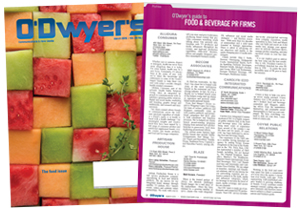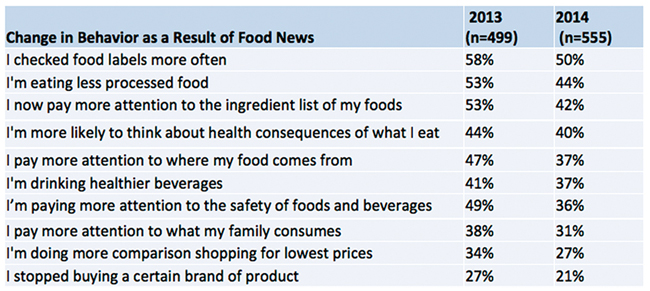 After years of being deluged with information regarding the importance of a healthy diet and understanding what’s in the food you eat and where it comes from, consumer fatigue may be setting in.
After years of being deluged with information regarding the importance of a healthy diet and understanding what’s in the food you eat and where it comes from, consumer fatigue may be setting in.
For more than a decade, Hunter PR has polled Americans regarding the top food stories of the year. When considering the impact of these stories on consumer behavior as well as the shifting tides of media consumption habits, a snapshot of America’s ever-evolving food media palate emerges. Our 12th annual Food News Study, conducted in partnership with Libran Research & Consulting, suggests that though food news remains an important part of the American consumer’s news diet, their appetite for acting on that news may be waning.
The pendulum swings
Among consumers who changed their behavior in 2014 as a result of food news, significant decreases can be seen year-over-year in almost every instance measured by the Hunter PR Food News Study for behaviors related to food and health, many of which were previously on the upswing.
|
|
For example, while 50 percent of consumers reported that they are “checking food labels more often,” this is an eight-point decrease from 58% in 2013. While 44 percent report they are “eating less processed food,” 53% claimed to be doing so last year. “Paying attention to ingredient lists,” is down 11%, the most of any behavior measured, from 53% in 2013 to 42% in 2014, a year when the “New Food Labeling Standards” was named the fourth biggest food story of the year. And though “The War on Sugar” landed at the number three spot in the Top Food Stories list, and “The Soda Calorie Cutback” was number seven, four percent fewer consumers reported that they are drinking healthier beverages in 2014 than the year prior as a result.
As compared to last year, in 2014 we see fewer Americans claiming that food & nutrition stories are “very important,” in general (28% vs. 32%), though 40% of Americans rated food-related news as more important than other news in 2014, which is on par from last year. If food related news remains important, why are the behavioral changes as a result of that news on the downswing? Could what’s making news and the resulting impact have to do with where a growing number of consumers are getting their information?
Millennials, the generation on every marketers mind these days, are the least likely of any age group to report changing many of these behaviors. Exercise, new foods and flavors, the environment, and technology have a stronger relationship to their eating habits than any other generation according to our study. They also consume news differently than any generation, and this is reshaping the overall food media landscape.
Social surges as food content source
When it comes to where consumers source food news, while websites, television, magazines and newspapers rank as the top sources of food related content, social media is making serious inroads into the dissemination of food information. Significant increases can be seen in social media as a source for recipes (up 7% from 2013 to 34% of the population) and nutrition information (up 8% to 22%). Not surprisingly, we see the greatest gains among Millennials, where Facebook is now the number-three source for nutrition information, and the number-one source for general food news among all measured.
|
|
Media channels influence awareness
When looking at the top food stories of the year through the lens of media channel consumption, it becomes clear that where each generation is accessing their news is directly correlated to the type of news they digest and consider important. Gen X-ers, Boomers and Matures all favor more traditional media sources (TV, radio, newspapers and magazines), where broader, less food-centric stories like the top two in this year’s study — the western wrought and the shrinking bee population, respectively — tend to be covered. But with Millennials, who get their general food news from Facebook more than any other source (30%) and are self-curating their social media content, pop culture and cause-related news stories dominated: (1) Coke’s “name” campaign, (2) GMOs, and (3) pumpkin spice mania.
Yes, you read that correctly — Coke’s marketing campaign encouraging shared moments of happiness was the number-one food news story of the year among Millennials, in the same year that “The War on Sugar” and “The Soda Calorie Cutback” were in the top ten overall, and four percent fewer consumers reported that they are drinking healthier beverages in 2014 than the year prior as a result.
What does this all mean for the modern food marketer? As always, an effective communications strategy must consider the target first, the channels they consume, and the type of information that lends itself to those channels, which in the age of social media often means 140-character, shareable bites and feel-good, pretty lifestyle pictures versus lectures and longer-form storytelling.
* * *
Samara Farber Mormar is Senior Vice President of Insights & Strategy at Hunter Public Relations.




 What the biggest meal of the day can teach us about serving up effective nutrition communications campaigns.
What the biggest meal of the day can teach us about serving up effective nutrition communications campaigns. Tips to refine and amplify your CPG brand strategy to win in 2024 and beyond.
Tips to refine and amplify your CPG brand strategy to win in 2024 and beyond. Strategic communications strategies for success in the growing “food is medicine” movement.
Strategic communications strategies for success in the growing “food is medicine” movement. How brands can authentically communicate sustainability issues and create a brand experience that’s compatible with consumers’ values.
How brands can authentically communicate sustainability issues and create a brand experience that’s compatible with consumers’ values. Communicating the effects that climate change and a growing world population have on our food system—and why change is needed.
Communicating the effects that climate change and a growing world population have on our food system—and why change is needed.


 Have a comment? Send it to
Have a comment? Send it to 
No comments have been submitted for this story yet.